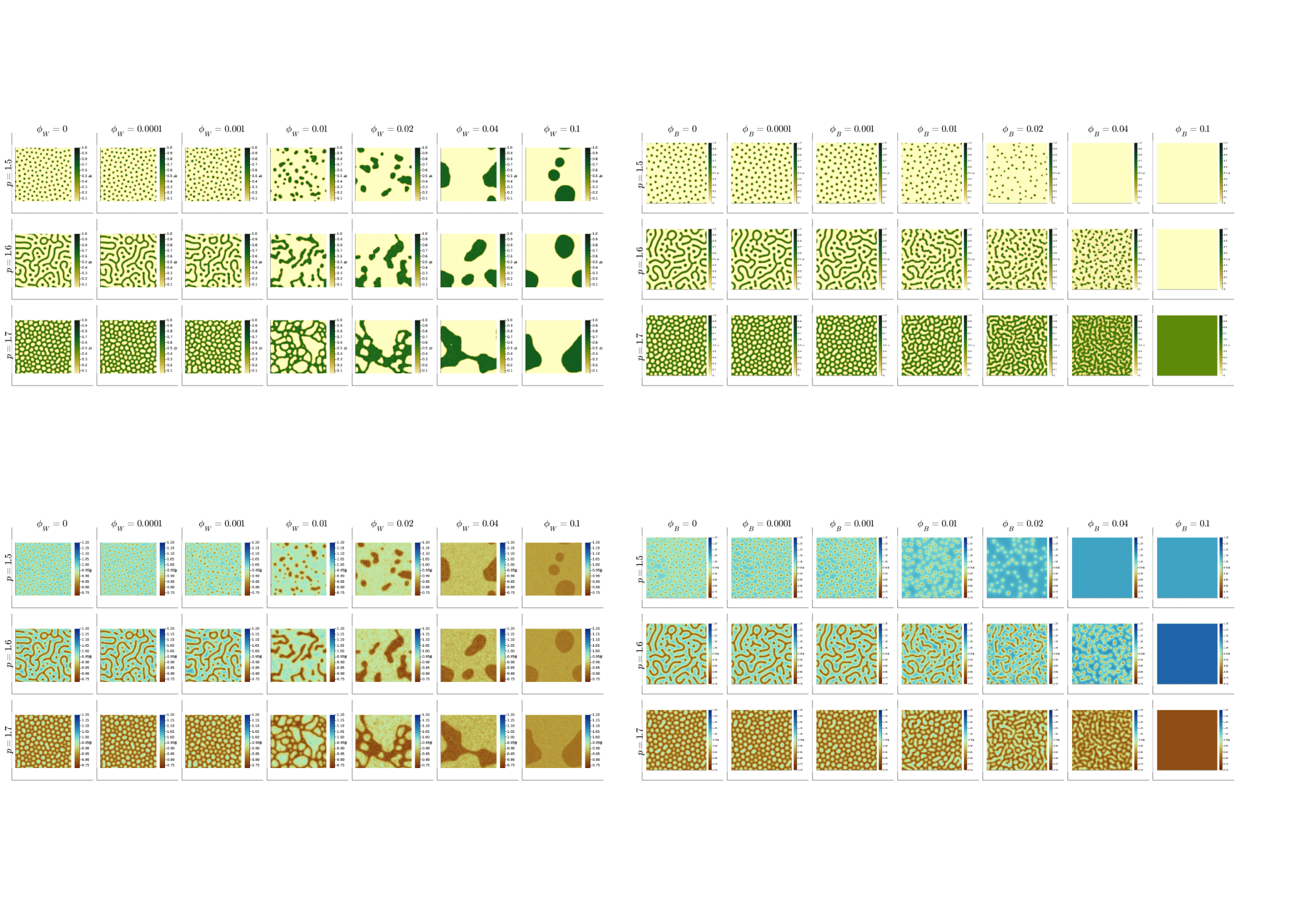Vegetation patterning dynamics induced by non-local connections
Ecosystem Sciences, Modeling
Research area
Vegetation patterns are a common feature of dryland ecosystems. The most frequently observed types are gaps, stripes/labyrinths and dots patterns, with a defined spatial scale, but irregular and scale-free patterns have also been recognized.
Various explanations have been provided for this phenomenon, our working hypothesis is that of vegetation self-organization. In arid and semi-arid ecosystems, several positive feedbacks encourage vegetation growth in the short range.
Concurrently, the different vegetation units compete for the limited water resource over a longer range.
The sum of these two mechanisms produces an instability to heterogeneous disturbances in the uniform vegetation solution at a certain precipitation value, below which the system falls into a stable patterned state.
The possibility to form patterned states improves the recovery capacity of the ecosystem since it breaks the large hysteresis cycle between desert and uniform vegetation solutions.
Project goals
In our project we investigate the effects of non-local connections on the process of pattern formation. Our starting point is a two-equation reaction-diffusion model, describing the dynamics of water and biomass densities in a 2-dimensional space. We modify the diffusive terms of this model to operate in a network space: each point in the spatial 2D grid represents a node in the network, and resources (water or biomass) diffuse from it to all its linked nodes. Following the Watts-Strogatz small world network model, starting from the 2D lattice, we draw shortcuts between a certain number of random nodes, preserving the original lattice links in the process. The number of shortcuts becomes a model parameter describing the topology of the diffusion network. We develop two different cases.
- Case 1: water diffuses through shortcuts, while biomass diffuses on the regular grid.
- Case 2: biomass diffuses through the shortcuts and water on the regular grid.
We study the sensitivity of the model to this parameter and evaluate how the stable pattern states change when they form over a different network topology. We believe our study may help explain the formation process of irregular and scale-free patterns, and predict their behaviour in front of changing environmental conditions.
Computational approach
At present, the model is implemented in Julia code. We employ the ParallelStencil.jl package, which allows us to solve the two model equations in parallel, greatly reducing the computational times and providing good efficiency and scaling.
Currently we are using a limited number of CPUs for each experiment (4/8) but we intend to perform a wider exploration of the parameters space, using large ensembles of simulations in parallel in order to estimate uncertainties.
To this end, in-house computational resources would not suffice and we are looking forward to use additional resources in the project to this end.
Further, simulations over larger domains would be useful to evaluate possible long distance ordering of our patterns but would require additional computing resources.
For this last purpose, we are interested in experimenting with the use of GPUs (for which our code is already ready thanks to the ParallelStencil.jl implementation), to improve scaling over larger domains.
Top-left: biomass density distribution resulting from 21 250-year model simulations, referring to case 1, at three different adimensional precipitation values (top to bottom) and seven different shortcut numbers (left to right).
Bottom-left: water density distribution resulting from the same simulations.
Top-right: biomass density resulting from 21 250-year model simulations, referring to case 2.
Bottom-right: water density distribution resulting from the same simulations.
Sara Filippini
Polytechnic University of Turin; OGS
My academic background lies mostly in Physics, with a particular interest in climate. In 2021, I gained a Bachelor's degree in Physical Engineering from Politecnico di Torino. That same year I moved to the Netherlands, to pursue a Master's degree in Climate Physics at the University of Utrecht, which I obtained in October 2023. My master's thesis focused on modelling the impact of natural climate change on the trade network of the late Roman period. In March 2024 I became a PhD candidate in Civil and Environmental Engineering at Politecnico di Torino, under the supervision of Jost von Hardenberg and Luca Ridolfi, focusing on pattern formation in drylands.










